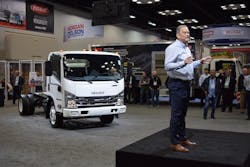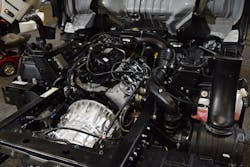Isuzu unveils two medium duty gas-powered trucks
Isuzu unveild two medium duty gasoline-powered trucks, the NPR and NPR-HD with a 6.6L V8 gas engine, during the Work Truck Show 2020 in Indianapolis this week.
“Some of the major challenges that we’ll face in this decade will result from emissions regulations, both CO2 and NOX,” said Shaun Skinner, president of Isuzu Commercial Truck of America, and president of Isuzu Commercial Truck of Canada. “These regulations will challenge our entire industry, but despite these challenges, we see tremendous upside in the next five years.”
Skinner went on to emphasize that the Isuzu NPR and NPR-HD are designed to preemptively handle future vehicle emissions regulations, and are a fit for the increase in the urban delivery and last market delivery vocations.
Later this year, the Class 3 NPR and the Class 4 NPR-HD will offer 6.6L V8 gasoline engines. “This engine provides the optimum combination of increased fuel efficiency, improved acceleration, and outstanding durability, all while meeting the next set of restrictive emission requirements,” Skinner said.
Highlights of the 6.6L V8 gasoline engine include direct fuel injection to provide fuel control, variable valve timing, 350 horsepower with a peak 425 lb-ft of torque at 3,800 rpm, and a design life of 200,000 miles. The vehicles will also feature a 38.6-gallon stainless steel fuel tank.
Production of the NPR and NPR-HD with the 6.6L V8 gasoline engine will begin in July of this year, said Skinner.
Isuzu also revealed that later this year, Isuzu will introduce a new 6L V8 gasoline engine in the Isuzu NQR and NRR, the company’s first gasoline engine offered in a Class 5 low cab forward truck. In the case of the NRR, it's the first 19,500 GVWR Class 5 low cab forward truck with a gasoline engine, said Skinner.
About the Author
Tyler Fussner
Associate Editor | Fleet Maintenance
Tyler Fussner is Managing Editor - Community Manager at Supply Chain Connect, part of the Design & Engineering Group at Endeavor Business Media.
Previously, Fussner served as the Associate Editor for Fleet Maintenance magazine. As part of Endeavor's Commercial Vehicle Group, his work has been published in FleetOwner magazine, as well as Bulk Transporter, Refrigerated Transporter, and Trailer-Body Builders.
Fussner's May 2022 print feature 'The dawn of hydrogen trucks' was named the best single technology article in B2B by the judges of the 2022 Folio: Eddie and Ozzie Awards. Fussner was also awarded Silver in the Technical Article category for the Trade Association Business Publications International (TABPI) 2021 Tabbie Awards.
Fussner previously served as Assistant Editor for Endeavor's Transportation Group on the PTEN, Professional Distributor, and VehicleServicePros.com brands.
Fussner studied professional writing and publishing at the University of Wisconsin-Whitewater. He has experience in shop operations, is a Michelin Certified Tire Technician, and a Michelin Certified Tire Salesperson.


